With this year’s holiday shopping season quickly approaching, you may be thinking about how to engage shoppers and increase sales for your retail business during this time of year.
There are several ways to do this, such as adding seasonal products to your inventory, boosting advertising, and offering major discounts. But considering that80% of global consumersfind that social interaction is better in-store, and 70% prefer in-store customer service, physical retail in the form of a holiday pop-up shop is a perfect low-cost holiday sales and marketing strategy to put to the test.
In this article, you’ll learn some of the main reasons why you should consider having a holiday pop-up shop and tips on how to get started.
Let’s dive in.
Table of Contents
What is a holiday pop-up shop?
The concept of a pop-up shop is nothing new. Think back to when you were a kid and what your first experience of earning money was. Many of us might have set up a lemonade stand, which is, in its most basic form, a type of pop-up shop. You start with a table and a very limited inventory, and once the sale is over, you close up shop, disassemble the table, and the lemonade sales are over.
Holidaypop-up shopsare any short-term, temporaryretail eventsthat take place during the winter holiday season. Thissales strategyis used to build brand awareness, test new markets, and increase sales. In fact, according toCapital One Shopping, temporary retail spaces generate up to $80 billion in annual revenue, and 80% of retailers that have opened a pop-up shop considered it a success. They’re an effective way to promote new products, engage with shoppers face to face, and build your customer base—all while keeping overhead costs low.
Reasons to host a holiday pop-up shop
Pop-ups can appear just about everywhere—at farmers markets, inshopping malls, within other retail businesses, and, thanks to the success of food trucks, in motorized vehicles as well. Anywhere you can imagine selling your goods can likely be turned into a pop-up shop.
Here are more reasons to host a pop-up shop this holiday season:
Grow an online brand
After Cyber Monday sales are over, you may want to consider hosting a pop-up shop, especially if you run a primarily ecommerce business. Physical shops are a great way to add a human element to your brand and engage customers offline.
FURTHER READING:Not sure about offline sales for your ecommerce business? Here are7 reasons you should consider in-person sales.
Many shoppers still want to see and touch items before they make purchases, and running a temporary offline store allows shoppers who may have been hesitant about purchasing online to test out and learn more about certain products.
Pop-up shops can also be an easy way to engage new customers who may not have come across your brand online.
Last-minute holiday shoppers are more likely to head tobrick-and-mortarstores and the mall to pick up gifts rather than browse for products online. Having a pop-up shop also lets you personally get to know your customers and build stronger relationships, which, in turn, drives customer loyalty long after the pop-up and holiday season is over.
Test a new revenue stream
The great thing about running a pop-up shop is that there are minimal costs associated with it compared to establishing a permanent brick-and-mortar store. According to a survey fromStorefront, 44% of businesses that have opened a pop-up shop spent less than $5,000 to run it. This makes it easier and less of a financial risk to experiment with new revenue streams as well as introduce new products and experiences.
If you’re a new business just starting out, setting up a pop-up shop is a good way to get a taste of opening a physical store and to see if you want to implement anomnichannel sales strategy. A pop-up offers a great way to get proof of concept for your products and ideas without the commitment of a full storefront.
And the holiday season is notoriously busy. You’ll encounter a diverse range of customers at a time of year when shoppers are most likely to purchase gifts and products they might not typically buy. That’s positive, as you’ll be able to get a varied sampling of shoppers to offer feedback on your products.
Boost sales
Perhaps the most enticing reason to consider a holiday pop-up shop is to increase sales. The temporary get-it-before-it’s-gone state of pop-ups naturally creates a sense of urgency amongst shoppers.
To create this sense of urgency, let your customers know when your pop-up begins and ends. Or, perhaps having limited inventory means the pop-up shop closes once your items are sold out.
Having a pop-up shop around the holiday season increases shopper urgency even more, since customers are aware of the exclusivity of seasonal products.
And to continue making sales even after shoppers leave your pop-up, consider using Shopify POS’semail cart feature. Email carts are the equivalent of abandoned cart emails for in-person shopping. Use them to convert shoppers who visit your pop up without buying anything into paying customers.
Reduce seasonal inventory
Pop-up shops can help shine a new light on old products. If you need to drive sales of seasonal or holiday inventory, especially before the end of the year, think about putting together a pop-up. Creating new displays and adding enticingvisual merchandising elementscan help attract different shoppers. Consider offering special deals, such as buy one, get one free, orbundling items together鼓励冲动购物。
Tap into peak shopping season
According to theNational Retail Federation, winter holiday shopping is the third most popular seasonal event and where consumers spend the most. In fact, the holiday season is so important for retailers that for some product categoriesit accounts for more than one-third of annual sales revenue. If you’re not tapping into this peak spending season, you ought to be. And a holiday pop-up shop is the perfect way to do it. You’ll reach new customers who are ready to spend, increase your holiday sales, and hopefully sell throughseasonal inventory.
Engage your local community
Meeting new customers when everyone has a warm and fuzzy holiday feeling is a great way to connect and engage with your local community (and sell more). And setting up a local holiday pop-up shop is a great way to attract local shoppers to your business. Thirty-five percent of consumers shop locally because they want to invest in their local community. You’ll be able to build customer relationships that last even after your holiday pop-up shop ends, and happy, loyal customers lead to brand advocacy.
全球百分之二十三的消费者说的ir top motivations for brand advocacy are the feeling of taking part/being involved, and 21% are more likely to share products with their friends and family if they have a personal relationship with the brand.
Reach new customers at a lower cost
The average cost to acquire new online customers is between$45 and $50, whereas the averagecustomer acquisition cost (CAC)in physical retail is $10. Hosting a holiday pop-up shop is a great way to penetrate a new market or neighborhood where your target market lives or hangs out, while keeping your costs down.
Plus, you’ll introduce your brand to more people, which, in turn, builds brand awareness and increases trust in your business. You can also use a pop-up shop as an opportunity to grow your email list. This way you can continue nurturing customer relationships long after the pop-up shop ends and turn in-person shoppers into repeat online customers at a lower CAC than you’d usually spend to gain new customers online.
Experiment with new pricing and promotional strategies
Peak shopping seasons are the perfect time to test new pricing and promotional strategies. You can experiment with differentretail pricing strategieson new products and promote limited-time special offers to encourage shoppers to make a purchase at your holiday pop-up store.
A few promotional strategies you can try are:
- Creating product bundlesto cross-sell and upsell, ultimately increasing average order value
- Buy one, get one free (BOGO)
- First-time customer discount
Whatever experiments you run, it’s key to make sure yourdiscount strategy isn’t slashing your retail profits.
Trial new products
The more eyes and feedback you get on new products the easier it will be to determine if you’re buying or making the right merchandise for your target market. It will also help you get insights into how to improve your products.
Use your holiday pop-up shop as an opportunity to gather immediate and useful feedback on product performance among pop-up shoppers. This way, you can gauge traction before investing more money into developing a new collection or stocking a new brand.
How to open a holiday pop-up shop
Now that we’ve discussed some of the reasons why you should consider hosting a holiday pop-up shop for your business, we’re going to offer some tips onhow to create a successful pop-up shop.
Holiday pop-up shops can be quick and easy to organize and can run for as long or as short as you choose. Here are some more things to keep in mind.
Focus on what to sell
Your holiday pop-up shop doesn’t have to be large. It can be as small as a single table or kiosk. With that in mind, it’s important to focus on selling a limited number of products, perhaps ones that fall into a certain theme, are seasonally appropriate, or that best represent your brand.
Another thing to consider when deciding what to sell at your pop-up shop is the cost of products. If you’re eager to reach the most customers and spread awareness about your brand—and clear out your seasonal inventory—choose products to sell at affordable price points that spark impulse buying. The idea here is to convert browsers into buyers, especially at a time when shoppers likely need to make multiple purchases while sticking to a holiday budget.
Set a budget and stick to it
Plan a pop-up shop the same way you would any business. This includes setting a budget and sticking to it. Some things you’ll want to keep in mind include:
- Cost of renting a space and utilities
- Furniture, including tables, chairs, and lighting
- Merchandising, such as tablecloths, signs, paint, and product displays
- Inventory
- Marketing and promotions
- Checkout, including point of sales and credit card fees
- Insurance, depending on the size of your pop-up shop and how long it’s running
Decide where to host your holiday pop-up shop
如前所述,弹出式商店可以出现just about anywhere. During the holiday season, be mindful of where you decide to set up your shop and how it will affect your business. Whether you’re popping up in your local neighborhood or testing out a new region where you’ve already seen online success, it’s important to place your pop-up shop in an area with high pedestrian traffic. This will increase the probability of people encountering your shop because they happen to be in the area. If you’re hidden or set up in an area where people aren’t likely to be shopping and ready to spend their money, it will impact sales.
Depending on your budget and resources, here are a few different types of pop-up locations to consider:
Pop-in stores
A pop-in store is when you temporarily rent space within an existing brick-and-mortar retail store. Companies likeWe Are Pop Upoffer the option for retailers to list their space on itsShopSharepage for brands to book on a temporary basis. For this strategy, it’s key to partner with retailers who reach a similar target audience. You can host this type of holiday pop-up shop for a weekend, a week, or longer. It all depends on you and the store owner.
Holiday markets
Event companies likeSip Shop EatandAmerican Field产生弹出,新兴市场和建立ob欧宝娱乐app下载地址ed brands attend to reach new audiences, build brand awareness, and boost sales. This setup is great for holiday pop-up shops because of the combined marketing efforts.
The event organizer and all the participating brands market the event, bringing in a lot of foot traffic. Of course, not every brand has the same target audience, so before you sign up for markets, ask about what other types of brands usually sell at the events. This way, you’ll have a rough idea of the type of consumers it attracts.
Leased commercial space
If you’ve found success online and are looking to expand into in-person selling, getting your own short-termretail leaseis a perfect way to test the waters. You can use sites such asThe StorefrontandWe Are Pop Upto find temporary retail leases. With this holiday pop-up strategy, you’ll be able to engage with customers in person, get feedback, and gauge whether opening a permanent retail store is right for your business.
Virtual pop-up shop
Holiday pop-up shops don’t have to be restricted to brick-and-mortar stores. Companies such asWe Are Women Ownedprovide platforms for virtual pop-up shops, or you can take things into your own hands.
Producing a virtual pop-up event doesn’t have to be a huge undertaking. You can start by doing the following:
- Rounding up a handful of local retailers or brands to collaborate with you on the event.
- Picking a date and time to hold the virtual event via Zoom or your preferred video chat service. One of Shopify merchants’ favorite apps isExperiences—it lets you host physical and virtual events through your online Shopify store.
- Creating digital assets that you and each participating brand can share via email and social media to promote the event.
- Asking consumers who would like to attend to sign up via an email form (this way you can send them a link to join the event).
- On the day of the event, give each brand the opportunity to share information about their business and where shoppers can find them online or in person.
与会者将无法购买的spot, but by collaborating with other local businesses to spread the word about your virtual pop-up you’ll all reach a wider audience (and grow your email list). Then you can follow up via email with shoppers who attended the event and provide links to each of the participating brands’ websites.
When partnering with other retailers, regardless of the type of pop-up shop you host, it’s essential to find brands that sell complementary products.
例如,有香味的蜡烛制造商建立一个pop-up shop within a florist, or accessory designers popping up in clothing stores selling a similar aesthetic. Sharing venues not only helps you reduce expenses, but each business benefits from the other’s foot traffic.
FURTHER READING:For more tips and tricks on finding the perfect location for your pop-up shop, read our guide:Pop-Up Shops and Everything Else You Need to Know to Try Temporary Retail.
Decide how you want to sell
Order fulfillment is another important part of hosting a holiday pop-up shop and can vary depending on your warehousing capabilities and inventory levels. Offering shoppers a range of ordering and delivery options, in the same way you would online or in-store, can help boost customer satisfaction and loyalty. Here are a few order fulfillment options you can try:
Endless aisles本质上是一样的购买店内,船到home, but it also lets you sell out-of-stock items through dropshipping. You can use the holiday pop-up shop as a showroom where customers can shop from limited inventory in-store and opt to have products shipped from your warehouse to their home or preferred delivery address.
Buy online, pickup in-store (BOPIS)is a popular order fulfillment option that helps reduce shipping costs for you and your customers. It’s commonly used by brick-and-mortar retailers, but you can also test it out at your holiday pop-up shop. Shoppers can shop and place an order online and pick it up at your pop-up store. This way, they’ll get their order faster, and there’s a chance they might increase their order size by purchasing additional items while they’re picking up their order.
Browse and buy in-storeis the traditional retail shopping experience, but is contingent on having enough space to hold inventory at your holiday pop-up shop. You can’t rely exclusively on this, especially if you have limited inventory and/or limited square footage for your pop-up store. Offering the option to buy in-store, ship to home is one way to navigate a small space, maximize in-store conversions, and improve customerretention rates.
Figure out how to process payments
No matter how you’re selling—online, in-store, or at a holiday pop-up shop—the payment process should be as frictionless as possible. Losing a shopper moments before they’re going to convert to a paying customer is not only disappointing but can hurt your bottom line. That’s why it’s vital to use a flexible point-of-sale system (POS) that lets you accept a wide range ofretail payment options, including credit and debit card payments, contactlessmobile paymentsvia Apple Pay and Google Pay, gift cards, and more.
WithShopify POS, you’ll also be able to create customer profiles so you can personalize post-purchase notifications and future marketing campaigns, manage inventory across all channels, offer various order fulfillment options, set up staff roles and permissions, and attribute sales to associates.
Learn more about POS systems
- What is a POS system?
- What is POS software?
- What POS hardware do stores need?
- How to choose the best POS system
- Which POS system features do you need?
- What is a mobile POS system?
- How much does aPOS system cost?
- What is a POS terminal?
- What is a touch screen cash register?
- What is a cash register POS?
- Why do small businesses need a POS system?
Decide on layout and pop-up shop design
Your pop-up shop layout, product displays, and décor—also known asretail merchandising—all help to create an in-store experience that drives sales.
Strategic design and merchandising are also valuable ways to differentiate your business from competitors and large online-only retailers.
In fact, according to our data, 85% of consumers in the US and Canada believe that local retailers provide a better store atmosphere than online retailers. As a result, 50% of merchants say they have improved their store experience to compete against online marketplaces.
Let’s take a look at four components of retail merchandising to consider for your next holiday pop-up shop:
Visual merchandising
Visual merchandisingrefers to anything that can be seen by the customer inside and outside a store, with the overall purpose of getting customers to make it past your front door and eventually to checkout.
It involves product displays, store design, mannequins, and more to help guide customers through your store.
Product displays
Globally, almost half of consumers still prefer to shop in-store, even the ones who also engage in online shopping.
Investing in retail product displays that help guide customers through your pop-up store is crucial. Depending on the types of products you sell, there aremany different product display optionsto choose from. You may use garment racks, tables, or wall shelving to display your products.
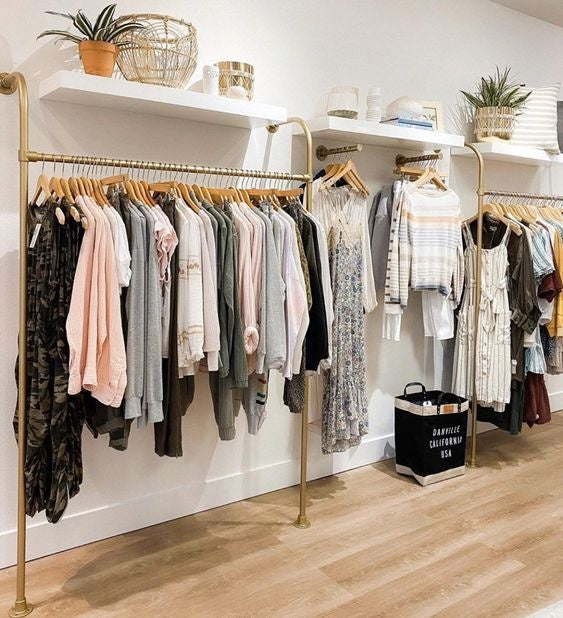
Cross merchandising
Cross merchandisingis a visual merchandising strategy that involves displaying complementary products next to each other. It’s also known as secondary product placement.
Cross merchandising makes the shopping experience more convenient for your customers and may inspire ideas or remind them of additional items they need. When done effectively, cross merchandising can result in both increased sales and increasedaverage order value (AOV).
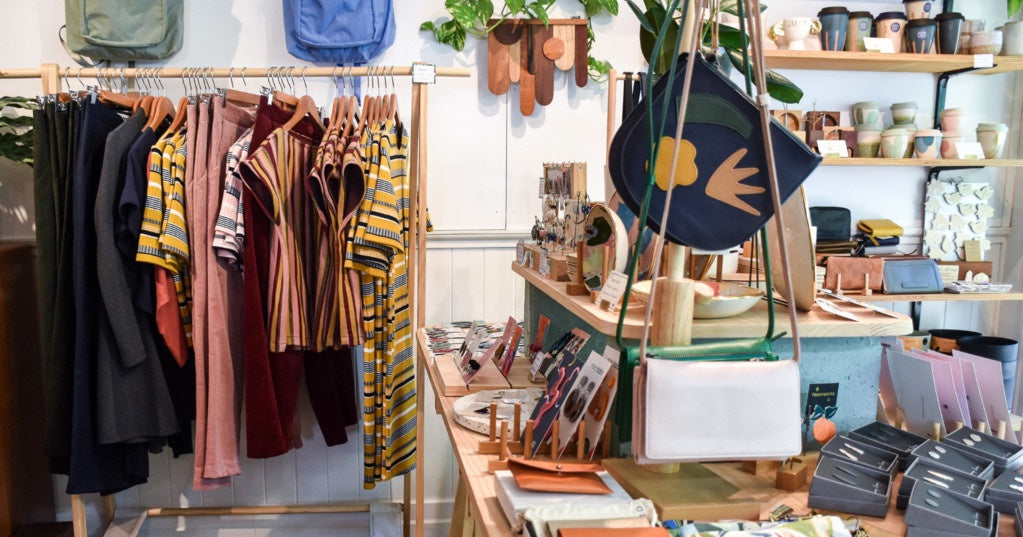
Cross merchandising is one of the best methods retail stores use to boost customer experience and increase sales, so trying it at your holiday pop-up shop is a no-brainer.
Window displays
If you’re leasing a commercial space for your holiday pop-up shop, yourwindow displayis one of the most powerful ways to make your store stand out. You’ll be competing with other small businesses as well as big-box retailers, so a one-of-a-kind window display will help set your holiday pop-up shop apart from the competition and draw in more customers.
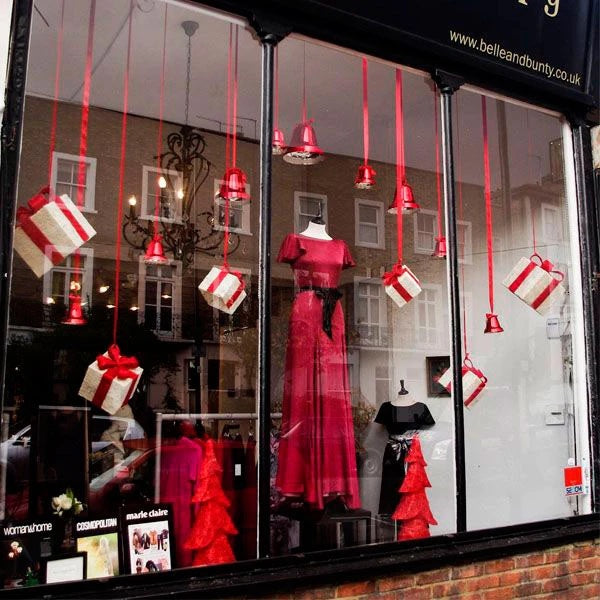
PRO TIP:In addition to merchandising your holiday pop-up shop, the placement of your point of purchase (POP)—where customers complete payment—is key. WithShopify POS, your entire store essentially becomes a POP. You and your staff all will be equipped with a mobile POS, enabling you to take payments and make sales anywhere in your pop-up shop.
Market your holiday pop-up shop locally
Now that you know the different types of holiday pop-up shops you can host, it’s time to think about how you’ll market the event locally. Here are a few ideas to get you started:
Team up with participating brands
Hosting a holiday pop-up shop in partnership with other brands is a great way to cross pollinate audiences. You can create a marketing calendar to encourage everyone who’s participating to promote the pop-up on the same days and times for a viral effect. Collaborating on discounts and promotions is also a great way to encourage local shoppers to support your holiday pop-up store.
You could say something like, “Your local brands are sticking together to encourage the support of small businesses in our community this holiday season! This Saturday only, enjoy 10% off all products at our pop-up shop on Main Street.”
Each business can promote the one-day sales event via their social media channels, email, and word of mouth. You’ll reach a larger audience and bring in morefoot trafficthan you could running the sale alone.
Get local media coverage
You can reach out to local media outlets and journalists to pitch your holiday pop-up event. However, sending random emails without a strategy could lead to no results and wasted time.
That’s why it’s crucial to create a powerful pitch by including the following details:
- Your brand story
- Something newsworthy to grab attention—for example, how you’re supporting a local cause and giving back to the community
- Why it’s timely and relevant—for example, announce a new seasonal product launch
Once you’ve created your pitch, target local publications. While pitching your business, it’s important to:
- spe的列一个清单cific reporters or bloggers you want to reach
- Personalize your outreach
- Follow up after one to two weeks
- Reach out via different channels (i.e., email and social media)
Put up a sidewalk sign
A surefire way to get the attention of local shoppers is signage. It’s even better if it’s in front of your pop-up store. Attract customers who are walking or driving by your holiday pop-up event by setting up a sidewalk sign outside your shop.
包括你的业务名称,弹出时间,“我们open!” and anything else you’d like to share to entice people in your neighborhood to come in. For example, a limited-time deal or a first-time customer special offer could help passersby decide to take a peek at what you sell.
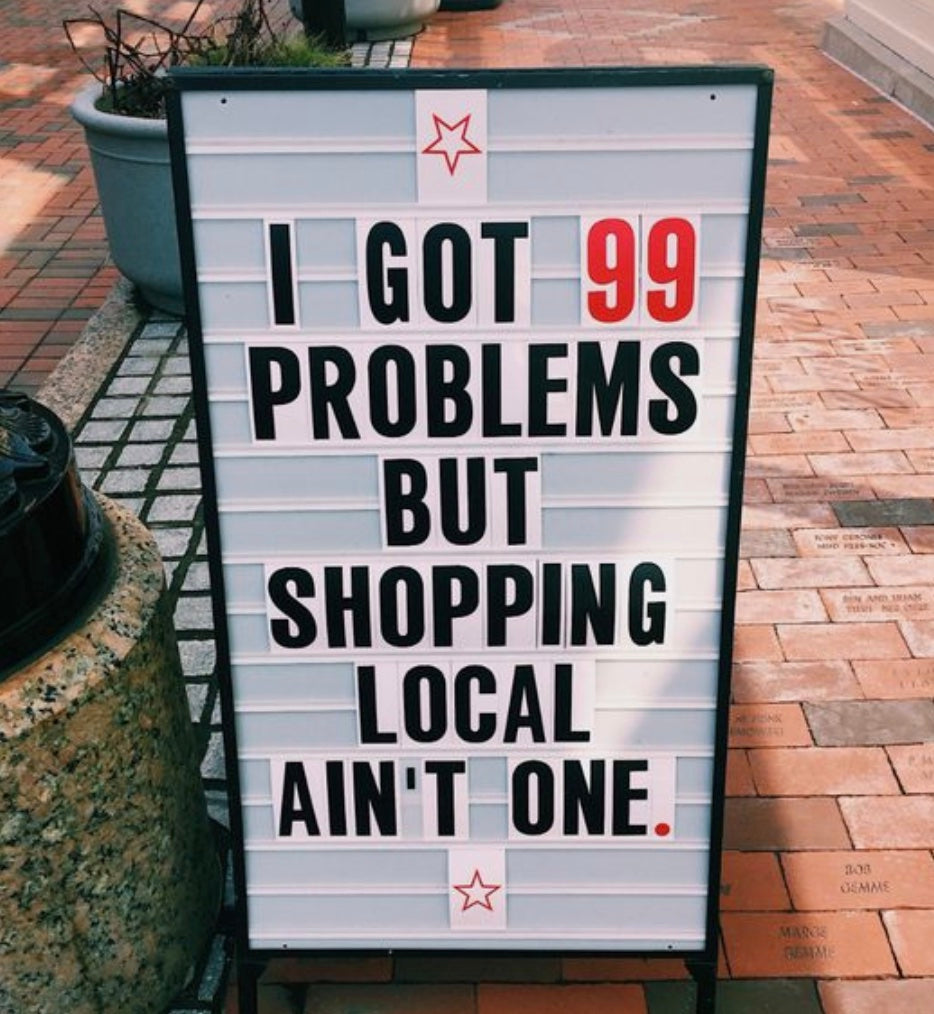
Use social media to encourage local customers to shop in person
In our research, we found that 57% of US shoppers discover local retailers through social media.
You probably already know social media is an effective channel to build brand awareness. It’s also a great way to communicate with your existing and prospective customers togive them a reason to visit your pop-up store.
Leading up to your pop-up event, post regular social media updates to:
- Educate shoppers about the benefits of shopping local this holiday season
- Explain why your products are unique
- Share photos and details about new items that are only available at your pop-up store
- Provide updates about pop-up event hours and safety protocol
- Let your followers know you’re available to answer questions via direct messages
- Show the behind the scenes of setting up and running your holiday pop-up shop
- Promote holiday pop-up special offers and discounts
Involve customers in your marketing activities
Thirty-five percent of consumerschoose to shop local because they want to invest in their community.
Getting customers involved in your marketing activities is win-win. They’ll feel accomplished in helping to strengthen the local economy and you’ll gain a few brand ambassadors for free.
Here are two low-cost strategies to get you started.
Ask for user-generated content (UGC)
User-generated content is content that gets created by customers, fans, or influencers and not by a brand. Many retailers work with influencers for UGC that gets posted onInstagram. Depending on the size of the influencer’s following, you may have to pay them for UGC.
Or, you could get your customers involved.
Use this as an opportunity to be transparent. Tell your customers you’re leaning on the community to help spread the word about your local holiday pop-up shop, then ask them to take pictures and share them via social media. This is a great way to involve your community in the shop local movement.
For example, you can ask customers who stop by your pop-up shop to “Post a photo to Instagram and tag @yourstorename for a chance to win 20% off your next purchase.”
Create a branded hashtag and add it to your Instagram bio. Hashtags are clickable, making them a great way to direct your followers to UGC that’s affiliated with a specific hashtag.
Collect email addresses and encourage email forwarding
Collecting email addresses from as many people as possible at your pop-up shop—including customers and browsers—is a great way to build out your marketing list for future marketing initiatives. Whether it’s an online sale, a new product launch, or the grand opening of your first brick-and-mortar store, keeping in touch with existing and prospective customers is a way to nurture relationships and increase repeat business.
And no matter the size of your existing mailing list, send a newsletter to your subscribers to let them know you’re hosting a holiday pop-up shop. Include specific details about pop-up days and hours and the precautions you’re taking to keep your customers and staff safe.
Then ask your subscribers to forward the email campaign to their local friends and family to help spread the word about your holiday event.
You can keep it short and sweet and say something like, “We appreciate your support and would be so grateful if you could forward this email to your local friends and family. Help us spread the word about shopping locally this holiday season!”
What to do once your holiday pop-up shop is done
After your holiday pop-up shop is over, it’s important to analyze your sales performance and the overall success of the event. You can start by reviewing the performance metrics we’ve listed below, as well as following up with visitors and customers after the event to get feedback.
Measure the performance of your pop-up shop
Without reviewing the performance of your holiday pop-up shop—or any pop-up shop, for that matter—you won’t know whether it was worth the time and money or how you can improve future events.
Here are a few pop-up shop performance metrics to analyze:
Average order value (AOV)is the average order amount a customer spends each time they make a purchase from your business. To calculate the AOV at your holiday pop-up, divide your total sales revenue from the event by the total number of purchases. Then you can compare this figure with the same metric for online sales during the same period to see which channel was more successful.
Net sales for your holiday pop-up shop is the total sales value after subtracting expenses for the event and thecost of goods sold (COGS)from yourgross salesat the event.
Here’s the formula:
Net sales = gross sales - (event expenses + COGS)
Break-even pointis when your product sales are equal to the expenses you incurred to run your holiday pop-up shop. There is no profit or loss, it’s simply the point where you made back your money. Doing abreak-even analysiswill help you understand how you can improve performance at your next pop-up event.
Items per orderis the average number of products purchased per a single customer order. Knowing this metric can help you make revenue predictions for future pop-up events. To calculate this value, add the total number of items purchased by each customer at the pop-up and divide it by the total number of purchases made at the pop-up.
For example, let’s say you had five customers and they bought the following number of products:
1 + 3 + 4 + 6 + 2 = 16
Among those five purchases, you sold 16 items.
Divide the total number of items sold by the total number of purchases:
16 / 5 = 3.2
Now we’ve learned that the average number of items purchased by one customer at your holiday pop-up shop is 3.2.
You can also compare this figure with the same metric for online sales during the same period to see which channel was more successful.
Bestselling products by net salesare the products you sold the most of when looking at yournet salesfigures. Depending on the point-of-sale you use at your pop-up shop, you should be able to get a quick view of your top selling products.
Top selling product types by net salesare the types of products you sold the most of at the pop-up event.
Sales attributed to marketingmight be harder to track at a holiday pop-up event unless customers opt for BOPIS after receiving an email campaign about the availability of this order fulfillment option. In this case, you’ll be able to track the online order back to the email campaign. This data can help determine if there is a demand for this option and potentially a permanent physical retail location so you can offer it on a regular basis.
Another old fashioned way to figure out if pop-up sales and attendance are attributed to your online marketing efforts is asking customers how they found out about the event. You can do this whether they make a purchase or not.
Email newsletter sign-upsat pop-up shops are crucial to continue engaging with browsers and customers after the event. They may not be ready to buy on the spot, but getting their email address will let you stay top of mind and hopefully convert more attendees into paying customers, online or at your next pop-up store.
Provide an incentive, such as “10% off your first purchase at the event or on your first online order in exchange for your email address.” You can encourage people to sign up by leaving an iPad or laptop out with signage displaying the special offer. And you can also mention it verbally. Then set a goal for the total number of email addresses you’d like to collect.
Customer acquisition costs (CAC)for your holiday pop-up shop can be calculated by adding up the total costs associated with acquiring new customers who made a purchase at the event. This is the amount of money you spent to host and market the event. Then divide that value by the total number of customers you acquired at the event.
For example, let’s say you spend $2,000 to host a holiday pop-up shop, including event space, product displays, and marketing, and at the event, you gain 100 new customers. Here’s how you’d calculate CAC for the pop-up:
$2,000 / 100 = $20
This means you spent $20 per new customer that you acquired at your holiday pop-up shop.
Engage with pop-up shop customers post-purchase
Engaging with shoppers post-purchase is important forcustomer retention, no matter what channel they use to buy your products. In the context of a pop-up shop you can follow up with customers via email to send a survey asking them about their experience.
You can also poll your email list and social media fans to get a pulse on whether your target market wants you to open a permanent retail store.
然后使用这些数据来通知你的策略r next pop-up event or your plans to open a retail location. But make sure you look atqualitative and quantitative data. A handful of people who say, “Yes, we love you! Open a store!” isn’t enough to be the main deciding factor in opening a brick-and-mortar location if you don’t have the sales numbers and profits to justify the investment.
You can also use post-purchase notifications as an opportunity tocross-sellsimilar products now that you have customer data.
Plan for the future
Did you hit your holiday pop-up shop sales goals? Are you happy with the results? Did your customers have a good shopping experience? Do your sales numbers prove that opening a permanent retail store might be the next step for your business?
Depending on your answers to these questions, you can consider hosting another pop-up shop or opt for theclick and mortarretail model to build on the success of your pop-up shop’s proof of concept.
5 brands with inspiring Christmas pop-up shops
Now you know how and why to open a holiday pop-up shop, it’s time for some inspiration from five brands who have been there and done it.
Callisters Christmas
Every day of every year, you can buy Christmas tree ornaments fromCallisters Christmas online store, and from October 2023, you can visit theirretail pop-up stores too. These add that extra visibility to excite new and renewed customers during the holiday season.
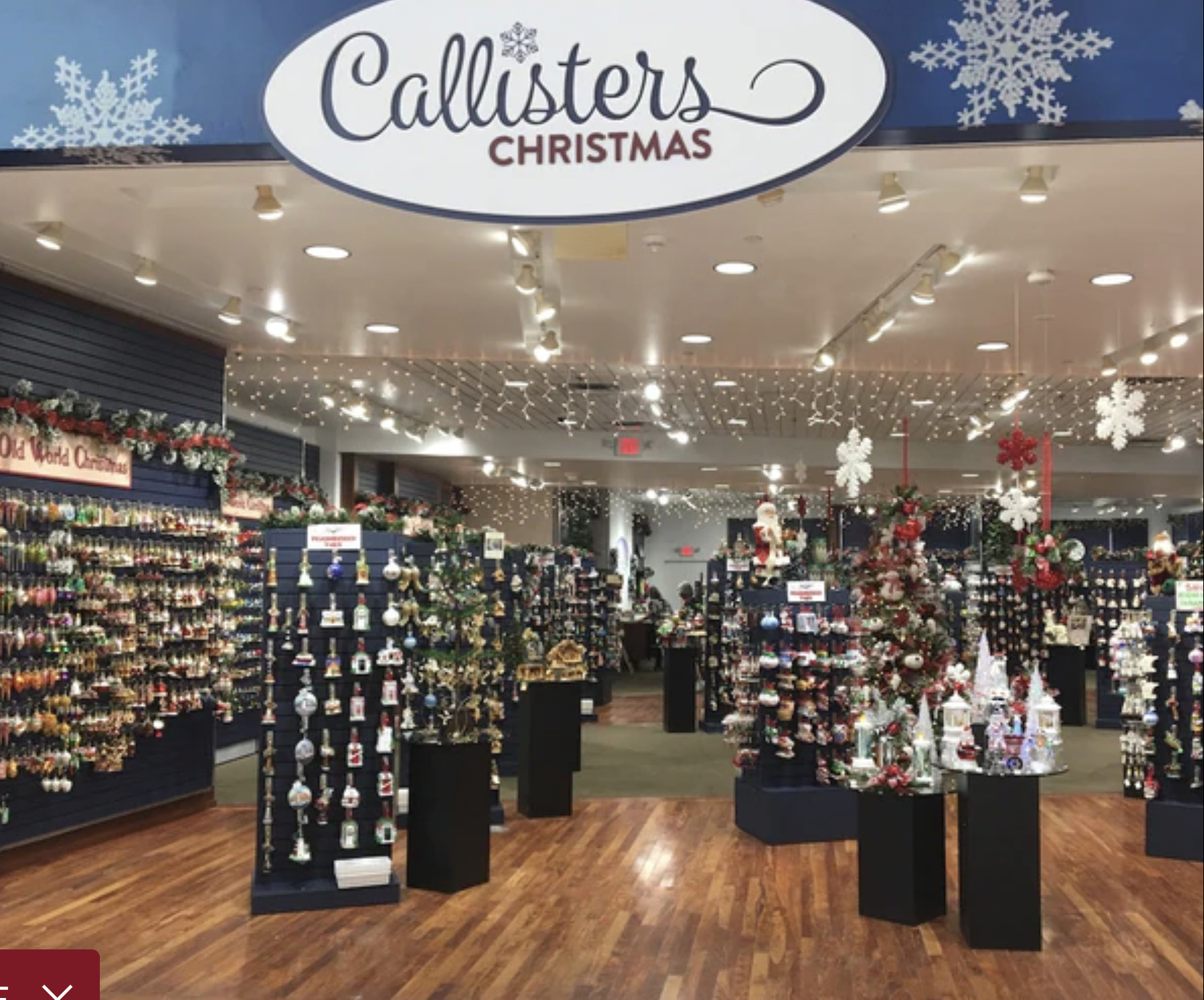
A Wink & a Nod
Jewelry, accessories, and bags are always at the top of mind for the team atA Wink & A Nodbut there’s something extra special during the holiday season, which is why they set up apop-up store in 2022and will again in 2023.
A Wink and A Nod-Christmas Show.mp4fromStacyonVimeo.
Bolé Road Textiles
Bolé Road Textilessells collections for various rooms in your home. In 2022, itset up a holiday pop-up storein Brooklyn, New York, so shoppers could see all of these styles in person.
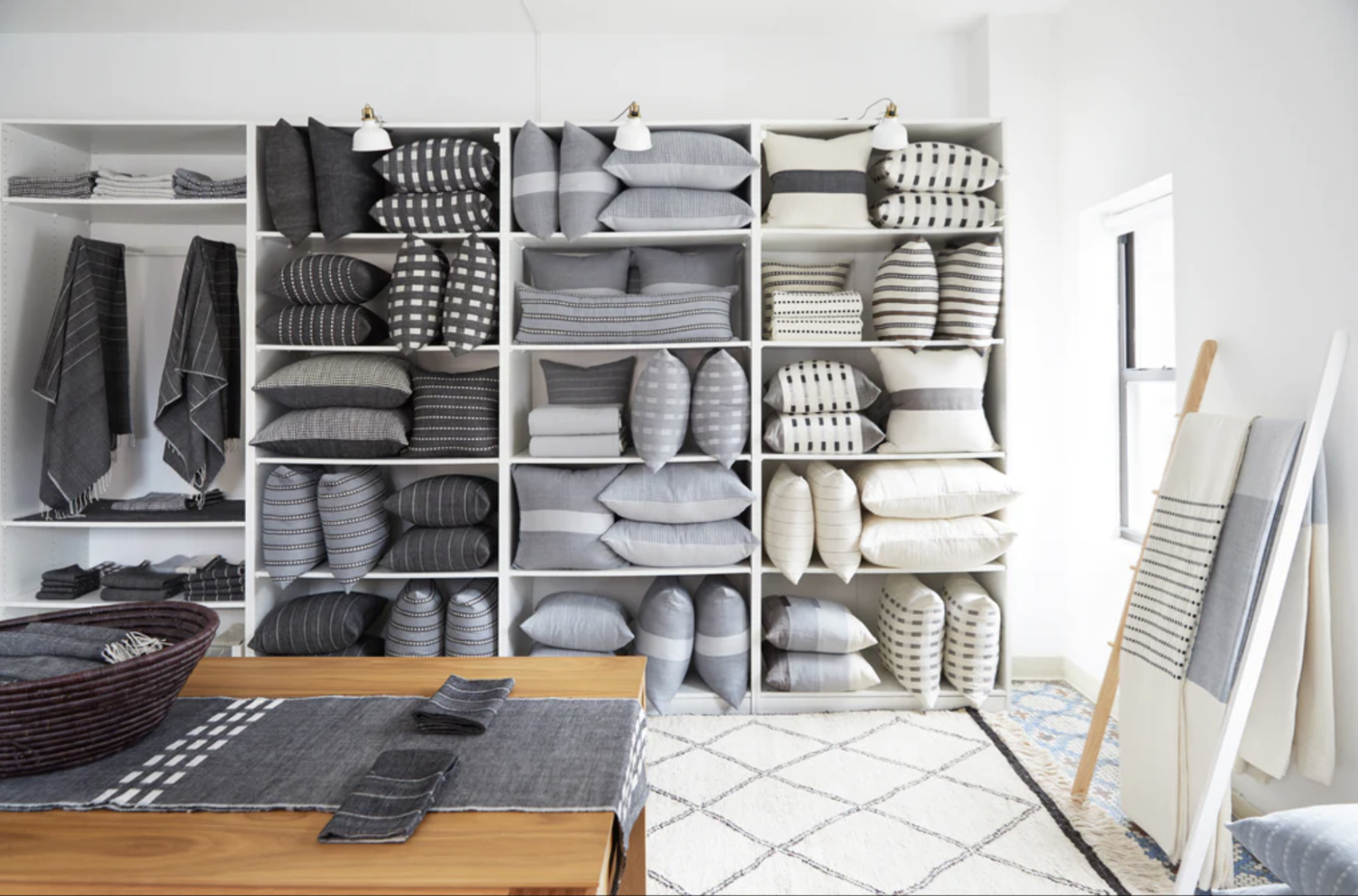
GiftyWrap
GiftyWrap都是关于传播与可回收的礼物或者说是快乐ap that celebrates the beauty of diversity. It sells online all year round but they love to meet their customers during the holiday season, which is why they set uppop-up events.
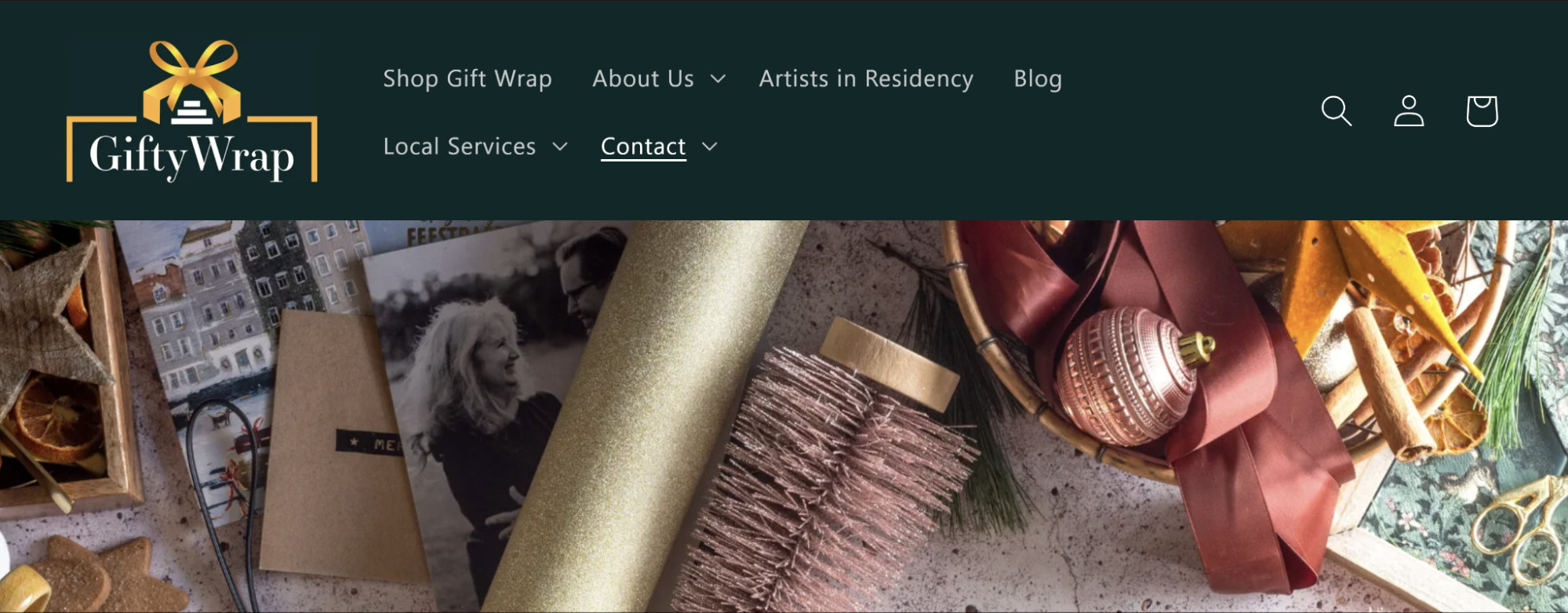
Aurelia Atelier
Last year,AureliaAtelier set up itsChristmas pop-up storefrom November 23 until December 26, based on the success of its 2021 version. It was a place to find special jewelry ideas for the important people in your life during the holidays.
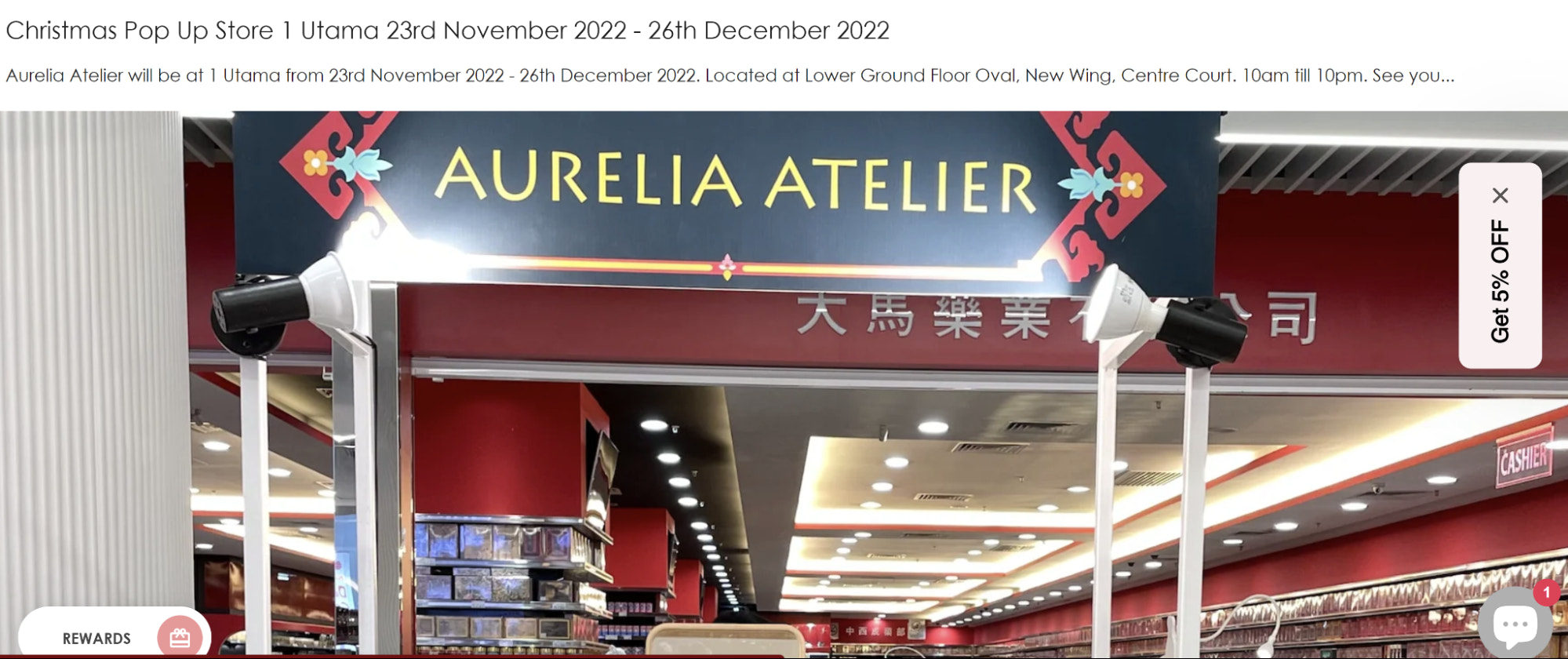
Moving forward with your holiday pop-up shop
Just like you did as a kid with your lemonade stand, have fun with your holiday pop-up shop. It can be a great opportunity for experimentation if you already run an offline store, and a chance to bridge the gap and add a humanistic element if you own an ecommerce business. With the boost in shoppers and increased spending, the holiday season is an ideal time to try something new. So, what are you waiting for? Get popping!
Get Shopify POS for your holiday pop-up
Have all the tools you need to manage your business, market to customers, and sell everywhere in one place. Unify in-store and online sales today.
Try Shopify POSHoliday pop up shop FAQ
How do I set up a pop-up Christmas shop?
- Choose a Location: Select a location for your pop-up Christmas shop. Consider factors such as foot traffic, ease of access, and competition.
- Gather Supplies: Purchase or rent supplies such as tables, racks, and shelves to set up your pop-up Christmas shop. You will also need to purchase decorations, gift wrap, and other supplies that you will need to run the shop.
- Promote Your Shop: Use online and offline marketing techniques to advertise your pop-up Christmas shop. Consider methods such as email campaigns, social media posts, and printed flyers.
- Set Up Your Shop: Set up your shop to make it look attractive and welcoming. Make sure to have a checkout counter and a return policy in place.
- Manage Your Shop: Hire staff to help you manage your pop-up Christmas shop. This will help to ensure that customers have a good experience and that you are able to maximize sales.

